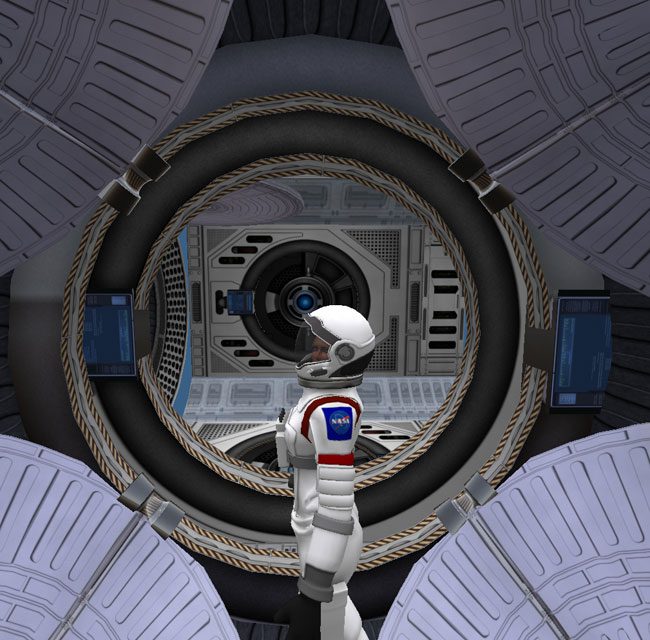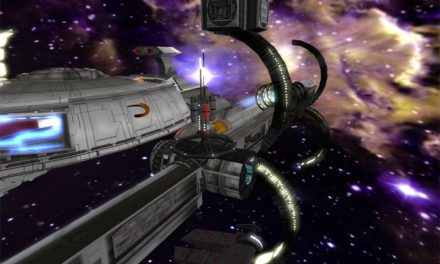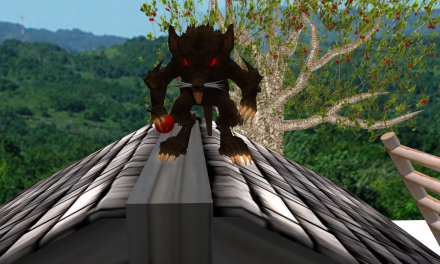 WASPS
WASPS
By
Patrick S. Baker
“Flash Traffic from NORAD!” Technical Sergeant Karen Scott, US Aerospace Force, Women’s Aerospace Patrol, announced from the communications’ station and turned on the speaker.
“. . . all mass-drivers! Multiple launches from Soviet territory. Thirty-six outbound, not, I repeat, not, standard ballistic flight paths!” A burst of static, a silence. “Estimated targets are defensive mass-drivers. Repeat: targets of multiple space launches are estimated to be missile defensive mass-drivers, high confidence. All drivers, acknowledge and stand-by for orders.”
“Acknowledge the traffic, Scott,” Ines Isabelle Leduc, Captain, USAF, WASP ordered. She flipped on the station wide intercom. “Everyone suit up and battle stations. We have less than eight minutes.”
The crew-women quickly donned their vacuum-suits and moved to their stations. Technical Sergeant Janet Muldoon took over communications, while Scott went to Module-2, the living quarters, to do damage control, if needed. Chief Master Sergeant Helen Bronski went into Module-3, which held the loading and firing mechanism for the mass-driver, in case they needed servicing. This left Module-4 the aiming and storage module unmanned. Master Sergeant Jedidiah Gold, the sensor NCO, powered up her active radar systems.
“All comms to broadcast station-wide,” Leduc ordered.
“Wilco,” Muldoon said and flipped a couple of toggle switches.
“All drivers, NORAD. Goblins are cylindrical, approximate fifteen yards length, three yards diameter.”
First Lieutenant Michaela Guzman, the executive officer, took the pilot’s seat to the commander’s left.
“About time, Lieutenant Guzman,” Leduc said, loudly. “The whole station is only 15 yards from end to end after all.”
“Yes, Ma’am.”
“Jesus, what a hard ass,” Scott whispered to Muldoon. Muldoon nodded in agreement.
“Something you want to say, Sergeant Scott?” Leduc called out the NCO.
“No, ma’am,” Scott replied.
“All drivers, NORAD Actual,” the Lieutenant-General in charge of all air and space defenses came on the radio. “Weapons tight, do not fire unless ordered to, or fired on. Take no action. This could just be a provocation, over. Driver Two-One will be the first encountered by goblin. Driver Two-One, you have the network, over.”
“Roger, NORAD,” Captain Jeri Freeh, the commander of Two-One, said. “Turning on the outside cameras. Goblin closing. Not trying to match orbits. Passing to our earth-side. Just ejected four objects, moving too slowly to be missiles. Objects are cylinders about two by six feet, they are on an intercept.”
The static-lined black and gray video transmission from Driver-Two-One’s camera’s showed the objects as the captain said.
“Slew! Slew!” Freeh ordered her pilot to swing the whole station into a new position. “Helmets!” the captain ordered her crew.
“Objects maneuvering to match us,” Freeh said, her voice now tinny as she spoke through her helmet radio. “Impact! Impact!”
The sound of tearing, wrenching metal came over the radio, followed the whoosh-hiss of escaping atmosphere.
“What the f. . . Broaders!”
There was the distinct, if thin, sound of gunfire and then deafening static.
“All drivers, NORAD, weapons free! Weapons free!”
Driver crews were all female. After Valentina Vladimirovna Tereshkova successfully completed her space flight in June 1963, the American space program, not to be outdone by the Soviets, started to seriously investigate sending women into space. In a series of experiments and all female space flights in 1964 and 1965, the US found that women made excellent astronauts. They tolerated both high g-forces and zero-g better than men. Their more efficient metabolisms required much less oxygen, water and food than male astronauts. In zero-g, women’s body strength was no issue. There was a huge argument over whether or not women could fight and kill if required. But, because the Mass-Driver only “killed” unmanned missiles, the Joint Chiefs of Staff decided that the question was moot. In 1967 President Johnson signed the Space Defense Authorization Bill, which created the US Aerospace Force and the Women’s Aerospace Patrol, as well as the Missile Defense Forces.
“What do you think happened?” Leduc asked.
“They got boarded. Sounded like gunfire,” Guzman said, matter-of-factly.
Leduc sat still, eyes wide in shock by what she had just heard.
“Designated Target Alpha is our bogey,” Gold said and fed the targeting data to Guzman’s pilot station.
Within the targeting analog computers various miter gears, differentials, roller integrators, cams, resolvers and torque servos moved and shifted through the calculations to hit the inbound enemy.
“Matching!” Guzman called out as she read the targeting data readout and the two crosses representing station and the enemy bogie moved together as she aimed the mass-driver by carefully angling the whole station to engage the oncoming attacker.
“Matched!” Guzman called out as the crosses met.
In the aiming module, the barrel of the mass-driver shifted on a set of gimbals and actuator rods.
“Captain, fire,” Guzman pleaded. “The firing solution is set. Fire, ma’am!”
The lieutenant stared at her commander. The captain’s blank expression spoke volumes.
Leduc finally managed to pull the firing trigger on her control stick.
The mass driver fired a 10-round burst of 20mm iron-tungsten slugs in under 30 seconds. The driver rounds left the rails at just over 5100 yards-per-second.
“Bogey maneuvering. Rounds missed. Bogey still maneuvering. I can’t get a solution.” Gold announced calmly.
“Ma’am,” Guzman said to her commander. “We can maybe get some of the other bogeys, if we can’t shoot ours.”
“Right,” the captain nodded slowly. “Gold, target any others we can accurately range.”
“Roger, ma’am!”
“Helmets, everyone,” Guzman ordered. Then said: “Send the outside video feed to the command console.”
“Roger, Ma’am,” Muldoon said, glad someone was giving orders.
“Their” bogey went past, 100 yards to earth-side of the station and ejected four coffin-sized canisters.
Leduc sat passively.
“I’m slewing at will,” Guzman declared. “Captain?”
Leduc sat still and silent staring at the oncoming enemy boarding pods.
“Damn,” Muldoon remarked to no one in particular. “Wish we had a couple of fifty cals. They’d blow those Commie truckers right out of space.”
Leduc looked at the NCO then she turned back to her screen. The enemy seemed to slowly crawl through the void toward her.
“Slewing!” Guzman announced.
The whole station turned on two axes as the pilot fired the maneuvering jets. The crew was pushed back into their seats. The first boarding-pod impacted Module-2. Without a word, Scott, fighting the decompression and the newly imparted movement of the station, pushed over to the survival kit connected to the wall. She grabbed out the M6 Air-Space Crew Survival Gun, an over-under folding stock weapon that chambered a .410 shotgun shell and a .22 Hornet round.
The hardened boarding-pod point came off and floated away. A Russian cosmonaut poked his head and his rifle barrel into the American spacecraft. Scott could see the cruel, bearded face of the Russian. She fired both barrels. Newton’s Third Law flung her against the hatch to Module-3. The Russian’s helmet cracked like an egg; globules of his blood and brains flowed through the shattered faceplate and drifted freely around the cabin.
The next boarding pod impacted into Module-2 as well. Seeing the second boarding-pod, Scott opened the hatch and drew herself down the tube connected to Module-3. Shutting the airtight hatch behind her and locking it, she pulled herself down the tube and into the driver module. She was greeted by Bronski wielding a yard-long monkey wrench. When the two recognized each other; both heaved sighs of relief and awkwardly hugged in their vac-suits.
“I nailed one of them,” Scott said.
“Good.”
“His head exploded everywhere,” the younger NCO said numbly.
Bronski held Scott as closely as possible. The shuttering quickly stopped and the senior NCO reported what had happened and where they were to Lieutenant Guzman.
“Get into Module-Four ASAP,” Guzman ordered.
The third boarder managed to hit right next to boarder number-two. The fourth one missed the station completely and continued on into deep space.
“Shit, ma’am,” Muldoon said. “I have a red light on the Module-Two hatch to the one-two tunnel. They have it open.”
The captain looked at the sergeant without expression.
“Jettisoning Module-Two.” Lieutenant Guzman said as she lifted the safety covers and hit the red button marked “JTS Mod-2”. Nothing happened.
“No response to jettison command,” the XO said.
“The wires must be cut, or the Russians disabled the leads somehow,” Muldoon said.
Leduc sat still. Guzman looked at her commander, waiting for the captain to say or do something; anything.
There was a pounding on the hatch to One-Two tunnel.
Gold pushed off of her seat and went to the survival pack on the wall and got out the M6, just like Scott had. The sergeant’s action shocked Leduc into action.
The captain pushed out of her chair to the hatch that lead to the One-Four gangway and swung it open and tried to go into the tunnel without saying a word.
“Leduc, what the hell are you doing?” Guzman called to her commander.
The lieutenant jumped over and wrapped the older woman in a bear-hug from behind and pulled her back into the command and control module. .
“Everybody down into Number-Four,” the XO ordered. “Gold, leave me the weapon.”
The Russians detonated a breaching charge. As Guzman was pulled back by the escaping air, she lost her grip on Leduc. The two WASPs went in different directions.
The M6 flew by the now spinning captain. Leduc reached out and grabbed the weapon. This action brought her back to her senses. She twisted and fired the .22. The recoil sent her spinning away in another direction. The cosmonauts ducked back behind the shards of the door. On Leduc’s next rotation she fired the shotgun. This round struck one enemy in the chest. The Russian spun away, not dead, but badly wounded, his vac-suit leaking air and blood.
The surviving cosmonaut leapt into the command-module and fired his AK. Three of his rounds hit Leduc as she floated, helpless. She pin-wheeled crazily as her suit sprayed air out of the punctures.
“What krot,” Captain Ines Isabelle Leduc coughed red foam. She shuttered and died.
Guzman slipped through the tunnel during the gunfight. She secured both ends of the tunnel from Module-One to Module-Four. Muldoon and Gold found Scott and Bronski waiting on them. Then NCOs quickly moved a box of freeze-dried breakfast meals out of the way to let Guzman get at the emergency control panel. All five WASPs secured themselves in emergency jump seats. Pushing two buttons, the Lieutenant active the station separation sequence. The barrel of the mass-driver ejected through the firing-port. The firing port closed and sealed shut automatically. Then the explosive bolts designed to separate all four module from each other fired. But only Module-Four separated from the rest of the station. The maneuver jets automatically fired and set the now detached sphere on a re-entry orbit.
Module-Four’s separation imparted a nasty, uncontrollable spin to the remains of the station. The automated systems, not knowing better, tried to put the rest of the station into a re-entry orbit. A maneuver that the station was not designed to perform.
For three hours Missile Defense Mass-Driver 18, spun and pitched and yawed and then burned up in the atmosphere, incinerating the bodies of the Russians and USAF Captain Leduc.
The survivors of Mass-Driver 18 landed in a cornfield in central Nebraska and were quickly taken to Offutt AFB by the farmer.
“The Russians captured 14, 19, 21 and 32 pretty much intact. Except for the crew of 21 the rest of the crews are hostages, but still alive, as far as we can tell. They boarded 11 but Captain Martini had armed her crew with the survival guns and smoked everyone one of the bastards before they could get out of their pods. 5, 11 and 18 were either destroyed or self-destructed. The Russian premier is saying this all a big mistake. Some of his generals went nuts and he will see they are punished. Also he’d like to get his cosmonauts back please and sorry about killing our WASPs and damaging our space stations. Of course, this is only because his plan didn’t work.” The intel colonel finished the briefing to the assembled officers and women of the WASPs.
Ninety days later Captain Ines Isabelle Leduc, USAF, WASP was awarded the first ever Distinguished Space Service Cross, posthumously.
Patrick S. Baker is a U.S. Army Veteran, currently a Department of Defense employee. He holds Bachelor degrees in History and Political Science and a Masters in European History. He has been writing professionally since 2013. His nonfiction has appeared in Medieval Warfare Magazine, Ancient Warfare Magazine, Sci Phi Journal, and New Myths. His fiction has appeared in the Sci Phi Journal, Flash Fiction Press as well as the King of Ages, After Avalon and Uncommon Minds anthologies. In his spare time he reads, works out, plays war-games, and enjoys life with his wife, dog, and two cats.




